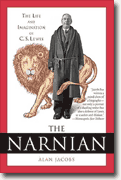The Narnian
Alan Jacobs
book reviews:
· general fiction
· chick lit/romance
· sci-fi/fantasy
· graphic novels
· nonfiction
· audio books
· author interviews
· children's books @
curledupkids.com
· DVD reviews @
curledupdvd.com
newsletter
win books
buy online
links
home
for authors
& publishers
for reviewers

 |
The Narnian: The Life & Imagination of C.S. Lewis Alan Jacobs HarperSanFrancisco Paperback 368 pages August 2006 |
|
If the book or film version of The Chronicles of Narnia has piqued your curiosity to learn more about their creator, you can glean a great deal from Alan Jacobs’s The Narnian: The Life and Imagination of C.S. Lewis. Why did C(live) S(taples) Lewis, who grew up in Ulster, Ireland, who earned a degree from Oxford University, and who for decades taught medieval and Renaissance English literature at his alma mater, begin at age fifty to write what have become classic children’s stories? Jacobs, a professor of English and director of the Faith and Learning Program at Wheaton College, where there is a significant collection of research material on Lewis, sets out to answer these questions in this fascinating biography.
Jacobs draws amply on Lewis’s writings (both fiction and nonfiction), as well as his correspondence and his older brother Warnie’s detailed personal journal, to support his contentions. Not only does Jacobs do a fine job of placing events in historical context and explaining cultural differences, he adequately refutes questionable prior interpretations of Lewis’s rationale for writing The Chronicles of Narnia. “Clearly Lewis’s imagination was a transforming one,” writes Jacobs. “He took the people he knew and loved, the great events he experienced, the books he read, and swept them all together into the great complicated manifold world of Narnia.” That Lewis’s vision is appealing is evidenced by the fact that 85 million copies of this work have been sold worldwide since its original publication. Originally published on Curled Up With A Good Book at www.curledup.com. © Jeanne Lesinski, 2006 |
|
|
|
 Click here to learn more about this month's sponsor! |
|
| fiction · sf/f · comic books · nonfiction · audio newsletter · free book contest · buy books online review index · links · · authors & publishers reviewers |
|
| site by ELBO Computing Resources, Inc. | |
 Rather than simply writing a chronological narrative, Jacobs focuses on Lewis’s intellectual life, his conversion to Christianity, and the turns his imagination took in his works prior to his writing the Narnia tales. Although during his lifetime Lewis was known as a scholar and proponent of Christianity, he is best known at the turn of the millenium for these children’s stories. The keynote of Jacobs’s book is his “belief that Lewis’s mind was above all characterized by a willingness to be enchanted and that it was this openness to enchantment that held together the various strands of his life—his delight in laughter, his willingness to accept a world made by a good and loving God, and (in some ways above all) his willingness to submit to the charms of a wonderful story.”
Rather than simply writing a chronological narrative, Jacobs focuses on Lewis’s intellectual life, his conversion to Christianity, and the turns his imagination took in his works prior to his writing the Narnia tales. Although during his lifetime Lewis was known as a scholar and proponent of Christianity, he is best known at the turn of the millenium for these children’s stories. The keynote of Jacobs’s book is his “belief that Lewis’s mind was above all characterized by a willingness to be enchanted and that it was this openness to enchantment that held together the various strands of his life—his delight in laughter, his willingness to accept a world made by a good and loving God, and (in some ways above all) his willingness to submit to the charms of a wonderful story.”